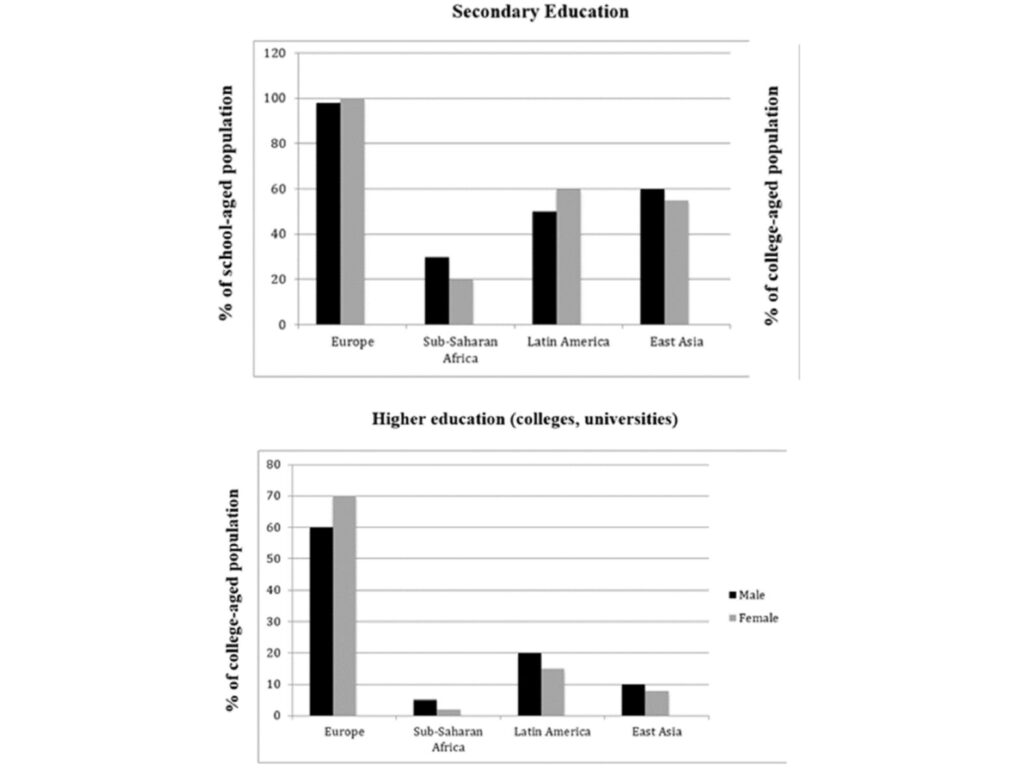Đề thi IELTS Writing ngày 22.2.2025
Task 1: The first chart below shows the percentage of school-aged girls and boys who were at secondary school in four regions of the world in 2000. The second chart shows the percentages of college-aged men and women in higher education in the same year.

Task 2: Some people think that the best way to reduce crime is to give longer prison sentences. Others, however, believe there are better alternative ways of reducing crime. Discuss both views and give your opinion.
SAMPLE ANSWERS
TASK 1
The two bar charts illustrate the proportion of male and female students enrolled in secondary and higher education across four regions in 2000.
Overall, Europe had the highest percentage of students in both secondary and higher education, while Sub-Saharan Africa had the lowest. Furthermore, the gap between male and female enrollments varied depending on the region and level of education.
In secondary education, nearly 100% of school-aged boys and girls in Europe were enrolled, making it the leading region. East Asia and Latin America followed, with approximately 50-60% of students attending school, and the gender disparity was minimal. However, in Sub-Saharan Africa, participation in secondary education was significantly lower, with fewer than 30% of boys and an even smaller percentage of girls attending.
Higher education followed a similar trend but with lower overall participation. Europe again had the highest proportion, with around 60% of men and 70% of women attending college or university. In Latin America and East Asia, the figures were lower, ranging between 10-20%, with men generally outnumbering women. In contrast, Sub-Saharan Africa had the lowest enrollment, with less than 5% of students continuing to higher education.
TASK 2
Crime is a pressing issue in many societies, and opinions are divided on how best to tackle it. Some argue that imposing longer prison sentences is the most effective way to deter criminals, while others believe that alternative approaches would be more successful in the long run. This essay will discuss both views before presenting my perspective.
On the one hand, those who support harsher punishments argue that they serve as a strong deterrent to potential offenders. When criminals know they will face severe consequences, they may think twice before engaging in illegal activities. Moreover, keeping offenders in prison for extended periods prevents them from committing further crimes, thereby enhancing public safety. Additionally, some believe that longer sentences allow more time for rehabilitation programs to take effect, ensuring that inmates can reintegrate into society as law-abiding citizens.
On the other hand, many believe that focusing on preventative measures is a more sustainable approach. One key strategy is improving education and employment opportunities, as studies have shown that poverty and lack of education are major contributors to crime. By providing vocational training and social support, governments can help individuals avoid turning to crime in the first place. Furthermore, investment in community policing and rehabilitation programs can address the root causes of crime, reducing reoffending rates more effectively than prolonged incarceration.
In my opinion, while tougher prison sentences may be necessary for violent offenders, they are not a one-size-fits-all solution. A combination of strict law enforcement and social reforms is the best way to achieve long-term crime reduction. By addressing the underlying factors that lead to criminal behavior, societies can build a safer and more just environment for all.